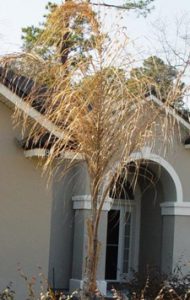
A: The short answer is you will have to wait until later in the spring by determining if any fronds come out green. The long answer is regarding which palms really can tolerate our colder winter weather. I know you are thinking you moved here because the average temperature is well above freezing, which is true, but nothing about this and the previous winter falls into the “average” category.
Queen palms, Syagrus romanzoffiana, have feathery fronds and tall slender trunks which reach heights of up to 50 feet. The cold hardiness zone for this palm is 9B – 11. We are in cold hardiness zone 8B-9A which is just above the Queen palm’s preferred area. This explains why so many of these palms have suffered over the last two years.
It would be better to choose a cold hardy palm such as Pindo, Cabbage, Chinese Fan or Indian Date. Refrain from planting the Pygmy Date Palm, Phoenix roebelenii, as it is also a south Florida palm in the 10-11 cold hardiness zones. The photos attached were taken by me last year after the freezing temperatures occurred and the Queen and Pygmy palms did not recover.
We have several cold hardy palms in the UF/IFAS Nassau County demonstration garden, which we will be refurbishing later this spring and summer. Remember to use palm fertilizer on your palms spring, summer and fall. For more complete information check out the publications from the University of Florida on the Queen palm: http://hort.ufl.edu/trees/SYAROMA.pdf and the Pygmy Date palm: http://hort.ufl.edu/trees/PHOROEA.pdf
 0
0
